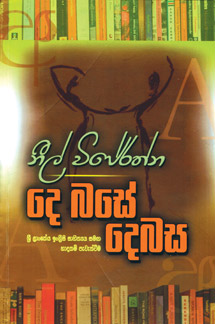Creative world of Sri Lankan English writers
 Is there a growing interest or an enthusiasm gathering in the
literary circles as regards on English writing in Sri Lanka? Though from
time to time English newspapers and their relevant literary supplements
take an interest on Sinhala literature, vice versa is hardly seen. Is there a growing interest or an enthusiasm gathering in the
literary circles as regards on English writing in Sri Lanka? Though from
time to time English newspapers and their relevant literary supplements
take an interest on Sinhala literature, vice versa is hardly seen.
Columnist Neil Wijeratne has shown a consistent interest towards the
subject. He has been guiding the Sinhala reader on the subject via a few
of his weekly Sinhala columns written to Sunday papers. As usual most
Sinhala columnists have the habit of collecting a pick of those columns
in order to go into the making of a complete work. Neil too has taken
steps to publish 28 of his Sinhala columns presumably to impart a sense
of understanding about those English writers, a few belonging to the
bygone days and a few living today.
His area of discussion centres around the aspects of the material
embedded plus various literary themes attached to them. Sometimes he
compares and attempts to make his own comments to kindle an interest in
the mind of the Sinhala reader. The collection of his Sinhala columns
written from time to time is titled aptly as Debase debasa (bilingual
discourse). The title is further described with a subtitle ‘Friendly
grips with Sri Lankan English literature’. Very briefly his intention is
clarified as a felt need to assess the stance of the English writer in
Sri Lanka.
The opening essay looks more like a preface to the entire collection
of essays. The subject selected for discussion is Gratiaen award for
literature. According to Neil W, there are pros and cons as regards the
very selection of works for awards. He tries to list some of the
discerning awards, and at the same time laments up to a point as regards
the position that they hold in a universal perspective.
 He selects such personalities as Michael Ondaatjee, Vijitha Fernando,
Tissa Abeysekara and a few others who are connected with the Gratiaen
award, and its formative stages. Then he tries to make his own judgment
on the bouquets and brickbats regarding the issues linked with Gratiaen
award. He selects such personalities as Michael Ondaatjee, Vijitha Fernando,
Tissa Abeysekara and a few others who are connected with the Gratiaen
award, and its formative stages. Then he tries to make his own judgment
on the bouquets and brickbats regarding the issues linked with Gratiaen
award.
As a conclusive tribute he sees that much service is rendered via
this annual award and the extent to which the original writer and his /
her translator is recognized. The second essay to my mind bears a witty
tone of those who were bilingual but not the strict promoters of a mixed
language commonly known to the Sinhala reader as Tuppahi. What the
writer intends to underline is the need to write one’s own country
English without aping or parroting any so called colonial English. This
essay to my mind raises several significant issues that have been
already raised in the linguistic high brow circles.
The third essay which centres round some of the views of the well
known writer Carl Muller is both the presentation of some alternative
views of a popular creative writer as well as the need to sensibly
listen or read the ideological differing view of another person. The
very presentation as a much detached scholar on the part of Wijeratne on
those alternative views is commendable. One serious point that emerges
out of the essay is the comment made by Carl Muller on the failure to
teach history as a subject, which he believes has given vent to the
misunderstanding of one’s own cultural identity in creative skills.
Several essays centre round the subject of women writers. This I
believe is a subject area taken seriously by the Sinhala women writers
of the day. Neil was a commentator takes synoptic view on some of the
contemporary women writers from India like Taslima Nasrin, and local
writers of the claibre of Anne Ransinghe, who had escaped from Nazi
holocaust, Punyakanthi Wijenaike, Eva Ranaweera, Jean Arsanayagam,
Sumathi Sivamohan, Yasmin Gunaratne, Chandani Lokuge etc. He underlines
the journalist Vijitha Fernando as one who single-handedly promoted
Sinhala short stories and novels to the English reader via her yeoman
dedication to a worthy cause. I quite agree with Neil on the matter as
we have observed her commencing from as far back as 1950s up to date.
Though commendable in attitude, I felt as a reader certain
overlapping and repetitions which have not been easy to delete in a work
of this nature. Brief discussion too ensues as regards Shyam
Selvadurai’s Funny boy and the Sinhala translation by Sugathapala de
Silva. I also felt that more could have been written about some of the
currently available anthologies of short stories, poems and selections
from novels in translation.
One example though cited briefly by Neil is Professor Christopher
Reynold’s compilation for the UNESCO. I know that this particular
anthology of Sinhalese literature did not receive the attention that it
deserved at the time of the publication. There are also references to
such writers as Elmo Jayawardane and Nihal de Silva. All in all the
insights are resourceful homework for the communication researchers of
the day.
[email protected]
|



